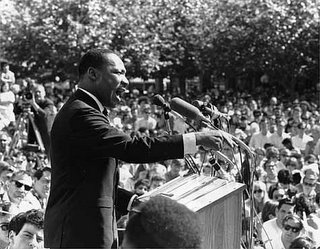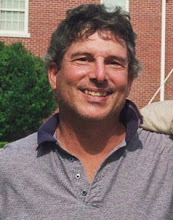RACE MATTERS

Dr. Martin Luther King's dream is not yet realized
(This column will appear in The Albany Journal 1/12/06)
1999
The woman was minding her own business, driving on a rural highway in Terrell County with her teenage daughter. Without warning she was blind sided by a car running a stop sign. Her car, struck on the passenger side, careened across the road and spun around. When it finally stopped, the woman lay bleeding and unconscious. An ambulance arrived and she was carted off on a stretcher. She racked up extensive medical bills, and her injuries were serious enough that her doctor kept her out of work for four weeks.
A year later her lawsuit seeking compensation for her lost wages, medical expenses, and pain and suffering went to a jury in the Terrell County Courthouse. Because liability was not disputed, the judge told the jury that the only issue they would be deciding would be the amount of damages to award. The defense put up no evidence contesting the medical expenses or lost wages and did not dispute the very real injuries suffered by the woman.
When the jury returned its verdict, the woman was stunned. The verdict awarded the medical expenses she had incurred, but only three weeks of her four weeks’ lost wages. The jurors did not award her a single penny for her pain and suffering. The woman had been bleeding and unconscious, injured seriously enough that her physician kept her out of work for almost a full month, but the jurors didn’t think she deserved a cent for pain and suffering, even though the law required they fully compensate her for her injuries. How could this be?
The jury was composed of 12 white people. The woman was black.. Did race matter? No other explanation made sense. Those jurors simply did not ascribe any value to her very real pain and suffering. The year was 1999.
2005
A few years later, a criminal case went to trial. The State’s evidence was so weak that all three bailiffs in the courtroom volunteered the opinion that the accused was not guilty and the jury would return an acquittal in short order. Bailiffs are law enforcement officers, and they generally have little sympathy for criminal defendants. By dint of sitting through hundreds of trials, they also get a good feel for what defendants are guilty or innocent and what prosecutions are solid or weak.
A day and a half of jury deliberations later, the judge was forced to declare a mistrial. The jury was stymied, with 10 voting not guilty and two voting guilty. The 10 voting not guilty were black. The two jurors voting guilty were white. The person on trial was black. The odds of the jurors ending up 10-2 for not guilty with the 10 being black and the 2 white were less than one in a million. Did race matter? The year was 2005.
1976
After I graduated from Duke Law School in Durham, North Carolina in May of 1976, I moved to Atlanta to look for work and study for the Georgia Bar examination. In September I was offered a job in Albany representing poor people in civil cases, working for Georgia Legal Services Programs, Inc., a non profit corporation commonly known as “Legal Aid.” I can still remember that during the long drive down from Atlanta I wondered whether I would have been brave enough to have made that journey ten years earlier, during the turbulent Civil Rights era. In those days it was physically dangerous to represent the poor or black people seeking to vindicate their legal rights. I remember reflecting on how easy I had it compared to the Northerners and Southern blacks who had been blasted with water cannons, beaten, and even murdered in Alabama and Mississippi during the era when Dr. Martin Luther King marched for freedom.
1986
By 1986 my career had taken some exciting turns, and my reputation as a lawyer willing to take on unpopular causes, including Civil Rights cases, was solidly established. At that point I was asked by Professor Lee Formwalt to sit on a panel discussion at Albany State College where the topic was how Albany had changed twenty-five years after the 1961 Martin Luther King marches and demonstrations here.
When Professor Formwalt told me he wanted me on the panel, my first reaction was to ask how I could intelligently discuss Albany’s progress since 1961 when I had only been here ten years. He suggested I do some reading at the Central Library, and for the first time I learned about the Albany Movement, courageous local citizens who spoke out for their brethren, and how Martin Luther King had attempted to change the official policies of segregation in schools, libraries and swimming pools, and the policies of discrimination against blacks who wished to vote or serve on juries. I came away from my reading with a great respect and regard for people like Student Non-violent Coordinating Committee representative Charles Sherrod, Attorney C. B. King, Dr. Walter Gordon and countless others who risked their personal safety to speak out on behalf of equal rights for all.
During the panel discussion I discussed the progress achieved as a result of the landmark cases which had brought Albany out of the Dark Ages, including voting rights suits, school desegregation cases, and public employment discrimination cases. But I also mentioned that along with privilege came responsibility. I discussed the fact that by 1986, the biggest obstacles to local black progress were no longer official government policies of exclusion, but self imposed failures like not exercising the hard won right to vote, the disintegration of two parent households, and the black on black crime that plagued large areas of the city.
2006
Twenty years after that panel discussion, much progress has been made on the official front. Albany has elected a black mayor and a black superior court judge with the help of many progressive white citizens and voters. Every large employer in the area has non discriminatory hiring practices, and all public areas and retail stores are open and available regardless of race. In those regards, Albany is nothing like it was 45 years ago when Dr. King came to town. But drugs, unemployment, crime, single parent and no parent households, are even worse than they were in 1986. White attitudes are rarely blatantly racist, but in the safe anonymity of the local Squawkbox or in jury rooms racism clearly still exists. As we celebrate Dr. King’s birthday, we should remember that the greater part of his work is still ahead of us.


0 Comments:
Post a Comment
<< Home